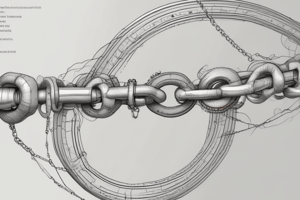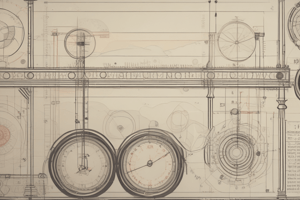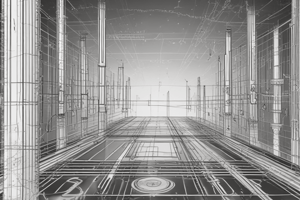Podcast
Questions and Answers
What is the primary concern of the modern industry in terms of component and product manufacture?
What is the primary concern of the modern industry in terms of component and product manufacture?
- Achieving a high degree of surface quality
- Meeting stringent demands of accuracy and precision (correct)
- Minimizing production costs
- Increasing production volume
What affects the accuracy of readings captured from line-graduated instruments?
What affects the accuracy of readings captured from line-graduated instruments?
- The original accuracy of the line graduations (correct)
- The skill of the user
- The type of attachment used
- The quality of the instrument
What is a key consideration in the design of instruments incorporating a scale?
What is a key consideration in the design of instruments incorporating a scale?
- Providing compensation against wear (correct)
- Increasing the precision of the instrument
- Improving the surface quality of the instrument
- Minimizing production costs
What is a primary concern when taking measurements with an instrument that makes contact with the surface of the job being measured?
What is a primary concern when taking measurements with an instrument that makes contact with the surface of the job being measured?
Why do digital instruments provide a chief advantage in signal processing?
Why do digital instruments provide a chief advantage in signal processing?
What is a potential drawback of using attachments with linear measurement instruments?
What is a potential drawback of using attachments with linear measurement instruments?
What is the primary factor that ensures accuracy in instruments such as callipers?
What is the primary factor that ensures accuracy in instruments such as callipers?
What is a key advantage of comparison measurement over direct measurement?
What is a key advantage of comparison measurement over direct measurement?
What is the fundamental principle of good design in linear measurement instruments?
What is the fundamental principle of good design in linear measurement instruments?
What is a critical requirement for a comparator to be effective in the industry?
What is a critical requirement for a comparator to be effective in the industry?
What is the advantage of dial versions of instruments?
What is the advantage of dial versions of instruments?
Why do comparators have an advantage over direct measurement instruments like vernier calipers and micrometers?
Why do comparators have an advantage over direct measurement instruments like vernier calipers and micrometers?
What is a key challenge in designing a comparator with high amplification?
What is a key challenge in designing a comparator with high amplification?
What is essential to ensure accurate measurements in linear measurement instruments?
What is essential to ensure accurate measurements in linear measurement instruments?
What is the primary benefit of using a micrometer over a steel rule?
What is the primary benefit of using a micrometer over a steel rule?
Why is linearity of the scale important in a comparator?
Why is linearity of the scale important in a comparator?
What is one of the factors that influence readability, apart from resolution?
What is one of the factors that influence readability, apart from resolution?
What is the primary purpose of a dial indicator?
What is the primary purpose of a dial indicator?
What is the typical range of linear measurements provided by a dial indicator?
What is the typical range of linear measurements provided by a dial indicator?
What is the function of the bezel clamp in a dial indicator?
What is the function of the bezel clamp in a dial indicator?
What type of comparator is classified based on the means used for comparison?
What type of comparator is classified based on the means used for comparison?
What is the primary advantage of mechanical comparators?
What is the primary advantage of mechanical comparators?
What is the typical material used for the contact point in a dial indicator?
What is the typical material used for the contact point in a dial indicator?
What is the purpose of a dial gauge in a metrology laboratory?
What is the purpose of a dial gauge in a metrology laboratory?
What is the main characteristic of a comparator?
What is the main characteristic of a comparator?
What is the main advantage of electrical comparators over mechanical comparators?
What is the main advantage of electrical comparators over mechanical comparators?
What is the principle of operation of an electrical comparator?
What is the principle of operation of an electrical comparator?
What is the main advantage of pneumatic comparators over other types of comparators?
What is the main advantage of pneumatic comparators over other types of comparators?
What is the typical application of pneumatic comparators?
What is the typical application of pneumatic comparators?
What is the range of dimensions that can be measured using pneumatic comparators?
What is the range of dimensions that can be measured using pneumatic comparators?
What is the main difference between electrical and electronic comparators?
What is the main difference between electrical and electronic comparators?
What is the function of the plunger in an electrical comparator?
What is the function of the plunger in an electrical comparator?
What is the primary purpose of screw thread limits?
What is the primary purpose of screw thread limits?
Which type of fit is characterized by a gap between the mating parts, allowing for easy assembly and disassembly?
Which type of fit is characterized by a gap between the mating parts, allowing for easy assembly and disassembly?
What is the distance a screw thread advances axially in one complete turn?
What is the distance a screw thread advances axially in one complete turn?
Which of the following is NOT a type of thread gauging method?
Which of the following is NOT a type of thread gauging method?
What is the purpose of regularly calibrating and inspecting measuring tools?
What is the purpose of regularly calibrating and inspecting measuring tools?
Which standard is commonly used in the United States for thread manufacturing and gauging?
Which standard is commonly used in the United States for thread manufacturing and gauging?
What is the primary advantage of using Coordinate Measuring Machines (CMM) for thread gauging?
What is the primary advantage of using Coordinate Measuring Machines (CMM) for thread gauging?
Why is it important to take thread measurements in a controlled environment?
Why is it important to take thread measurements in a controlled environment?
Flashcards are hidden until you start studying
Study Notes
Linear Measurement Instruments
- Designed to meet high demands of accuracy and precision, while being simple to operate and cost-effective
- Important considerations for design:
- Measuring accuracy depends on the original accuracy of line graduations
- Instruments with scales require compensation against wear
- Attachments can enhance versatility but also contribute to accumulated error
- User skill is essential for accurate measurements
- Principle of alignment: line of measurement and line of dimension being measured should be coincident
- Electronic versions provide convenience, but basic principles must be adhered to
- Readability is crucial, and instruments with better readability are more reliable
- Digital instruments offer ease of signal processing and direct expression of readings in required form
Comparators
- Must provide high accuracy and precision, convenience, and withstand rough operating environments
- Major requirements:
- High accuracy and precision
- Linear scale with a wide range
- High amplification
- Good resolution
- Provision for temperature compensation
- Versatility with attachments and flexible means
- Classification of comparators:
- Mechanical comparators
- Mechanical-optical comparators
- Electrical and electronic comparators
- Pneumatic comparators
- Other types (projection, multi-check)
Mechanical Comparators
- Provide simple and cost-effective solutions
- Skills for fabrication and use can be learned relatively easily
- Important comparators in metrology:
- Dial Indicator: used to compare workpieces against a master, with interchangeable contact points and a scale that provides the required least count
Electrical Comparators
- Use electrical signals for measurement
- Main elements:
- Plunger (sensing element)
- Armature
- Coils
- Output display device
- Can achieve high magnification (up to 10^5:1)
Pneumatic Comparators
- Use air as a means of measurement
- Basic principle: changes in calibrated flow respond to changes in part feature
- Advantages:
- Absence of metal-to-metal contact
- Higher amplification
- Low cost
- Can be used for inspecting multiple dimensions of a part in a single setting
Thread Measurement
- Screw thread limits define the acceptable range of thread dimensions
- Key parameters:
- Major Diameter
- Minor Diameter
- Pitch Diameter
- Lead
- Pitch
- Fit limits determine how tightly or loosely the threaded parts will fit together
- Tolerance classes:
- Unified Thread Standard (UTS)
- ISO Metric Thread
- Gauging methods:
- Go/No-Go Gauges
- Thread Micrometers
- Optical Comparators
- Coordinate Measuring Machines (CMM)
Studying That Suits You
Use AI to generate personalized quizzes and flashcards to suit your learning preferences.





